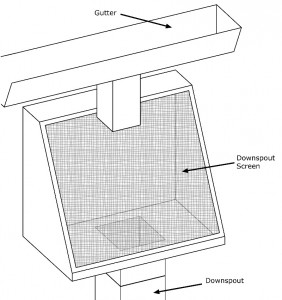The goal of pre-storage treatment is to clean the rainwater runoff as much as possible before it enters the storage tank. This helps to reduce organic matter from collecting in the tank, and it reduces the amount of treatment needed after storage. Pre-storage treatment targets “large” debris that can easily be seen. It is done by two different methods: diversion or screening.
Diversion
 Diversion is when the first flush of roofwater runoff is collected and separated from entering the storage container. This sacrificial first flush of water has been found to contain the most amount of debris from the roof surface. Common names for these devices include a roof washer and first flush diverter. This image shows a basic first flush diverter, which can be made from PVC pipe and fittings. The key to a successful first flush diverter is to empty the chamber after each rain event. This clears debris and makes space for the next rain event. This example has a slightly-opened hose bib to slowly drain the chamber between rain events. The size of the diverter chamber is a topic of debate and varies depending on surrounding trees and your area’s rainfall intensity. In general, we recommend about 1-2 gallons of diversion for every 100 square feet of catchment area.
Diversion is when the first flush of roofwater runoff is collected and separated from entering the storage container. This sacrificial first flush of water has been found to contain the most amount of debris from the roof surface. Common names for these devices include a roof washer and first flush diverter. This image shows a basic first flush diverter, which can be made from PVC pipe and fittings. The key to a successful first flush diverter is to empty the chamber after each rain event. This clears debris and makes space for the next rain event. This example has a slightly-opened hose bib to slowly drain the chamber between rain events. The size of the diverter chamber is a topic of debate and varies depending on surrounding trees and your area’s rainfall intensity. In general, we recommend about 1-2 gallons of diversion for every 100 square feet of catchment area.
Screening
 Debris screens filter out large contaminants before they end up in the storage container. There are several locations along the conveyance network where they can be used. The first type is the gutter debris screen. This device attaches to a gutter and removes leaves and other debris from entering the system. Gutter screens come in many styles. Regardless of manufacturer claims, you should check these screens on a regular basis to make sure they don’t become clogged. Screens can also be placed on the downspout as seen in this picture. This type of screen removes leaves and debris that drains from the gutter. Because of the angle of the screen, the debris should fall away. Another screen type is the basket screen. This screen fits into the inspection port/inlet of the storage container and catches debris falling into it. With this type of screen, it is critical that it is emptied out after each rain event. (The picture below shows a basket screen full of crickets.)
Debris screens filter out large contaminants before they end up in the storage container. There are several locations along the conveyance network where they can be used. The first type is the gutter debris screen. This device attaches to a gutter and removes leaves and other debris from entering the system. Gutter screens come in many styles. Regardless of manufacturer claims, you should check these screens on a regular basis to make sure they don’t become clogged. Screens can also be placed on the downspout as seen in this picture. This type of screen removes leaves and debris that drains from the gutter. Because of the angle of the screen, the debris should fall away. Another screen type is the basket screen. This screen fits into the inspection port/inlet of the storage container and catches debris falling into it. With this type of screen, it is critical that it is emptied out after each rain event. (The picture below shows a basket screen full of crickets.)
